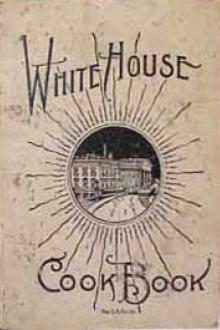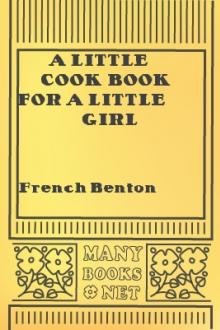The Whitehouse Cookbook (1887), Hugo Ziemann [world of reading .TXT] 📗

- Author: Hugo Ziemann
- Performer: -
Book online «The Whitehouse Cookbook (1887), Hugo Ziemann [world of reading .TXT] 📗». Author Hugo Ziemann
Peaches, raspberries, blackberries and huckleberries can be substituted for strawberries. Always send to the table with a pitcher of sweet cream.
ORANGE SHORT-CAKE.
Peel two large oranges, chop them fine, remove the seeds, add half a peeled lemon and one cup of sugar. Spread between the layers of short-cake while it is hot.
LEMON SHORT-CAKE.
Make a rich biscuit dough, same as above recipe. While baking, take a cup and a quarter of water, a cup and a half of sugar, and two lemons, peel, juice and pulp, throwing away the tough part of the rind; boil this for some little time; then stir in three crackers rolled fine; split the short-cakes while hot, spread with butter, then with the mixture. To be eaten warm.
HUCKLEBERRY SHORT-CAKE.
Two cupfuls of sugar, half a cupful of butter, one pint of sweet milk, one tablespoonful of salt, two heaping teaspoonfuls of baking powder sifted into a quart of flour, or enough to form a thick batter; add a quart of the huckleberries; to be baked in a dripper; cut into squares for the table and served hot with butter. Blackberries may be used the same.
FRIED DINNER-ROLLS.
When making light raised bread, save out a piece of dough nearly the size of a small loaf. Roll it out on the board, spread a tablespoonful of melted butter over it. Dissolve a quarter of a teaspoonful of soda in a tablespoonful of water and pour that also over it; work it all well into the dough, roll it out into a sheet not quite half an inch thick. Cut it in strips three inches long and one inch wide. Lay them on buttered tins, cover with a cloth and set away in a cool place until an hour before dinner time; then set them by the fire where they will become light. While they are rising, add to a frying-pan a tablespoonful of cold butter and one of lard; When it boils clear and is hot, lay as many of the rolls in as will fry nicely. As soon as they brown on one side turn them over and brown the other; then turn them on the edges and brown the sides. Add fresh grease as is needed. Eat them warm in place of bread. Nice with warm meat dinner.
NEWPORT BREAKFAST-CAKES.
Take one quart of dough from the bread at an early hour in the morning; break three eggs, separating yolks and whites, both to be whipped to a light froth; mix them into the dough and gradually add two tablespoonfuls of melted butter, one of sugar, one teaspoonful of soda, and enough warm milk with it until it is a batter the consistency of buckwheat cakes; beat it well and let it rise until breakfast time. Have the griddle hot and nicely greased, pour on the batter in small round cakes and bake a light brown, the same as any griddle cake.
PUFF BALLS.
To a piece of butter as large as an egg stirred until soft; add three well-beaten eggs, a pinch of salt and half a teacupful of sour cream. Stir well together, then add enough flour to make a very thick batter. Drop a spoonful of this into boiling water. Cook until the puffs rise to the surface. Dish them hot with melted butter turned over them. Nice accompaniment to a meat dinner as a side-dish—similar to plain macaroni.
BREAKFAST PUFFS.
Two cups of sour milk, one teaspoonful of soda, one teaspoonful of salt, one egg and flour enough to roll out like biscuit dough. Cut into narrow strips an inch wide and three inches long, fry brown in hot lard like doughnuts. Serve hot; excellent with coffee. Or fry in a spider with an ounce each of lard and butter, turning and browning all four of the sides.
ENGLISH CRUMPETS.
One quart of warm milk, half a cup of yeast, one teaspoonful of salt, flour enough to make a stiff batter; when light, add half a cupful of melted butter, a teaspoonful of soda dissolved in a little water and a very little more flour; let it stand twenty minutes or until light. Grease some muffin-rings, place them on a hot griddle and fill them half full of the batter; when done on one side turn and bake the other side. Butted them while hot; pile one on another and serve immediately.
PLAIN CRUMPETS.
Mix together thoroughly while dry one quart of sifted flour, loosely measured, two heaping teaspoonfuls baking powder and a little salt; then add two tablespoonfuls of melted butter and sweet milk enough to make a thin dough. Bake quickly in muffin-rings or patty-pans.
PREPARED BREAD CRUMBS.
Take pieces of stale bread, break them in small bits, put them on a baking pan and place them in a moderate oven, watching closely that they do not scorch; then take them while hot and crisp and roll them, crushing them. Sift them, using the fine crumbs for breading cutlets, fish, croquettes, etc. The coarse ones may be used for puddings, pancakes, etc.
CRACKERS.
Sift into a pint of flour a heaping teaspoonful of baking powder, four tablespoonfuls of melted butter, half a teaspoonful salt and the white of an egg beaten and one cup of milk; mix it with more flour, enough to make a very stiff dough, as stiff as can be rolled out; pounded and kneaded a long time. Roll very thin like pie crust and cut out either round or square. Bake a light brown.
Stale crackers are made crisp and better by placing them in the oven a few moments before they are needed for the table.
FRENCH CRACKERS.
Six eggs, twelve tablespoonfuls of sweet milk, six tablespoonfuls of butter, half a teaspoonful of soda; mold with flour, pounding and working half an hour; roll it thin. Bake with rather quick fire.
CORN MEAL MUSH OR HASTY PUDDING.
Put two quarts of water into a clean dinner-pot or stewpan, cover it and let it become boiling hot over the fire; then add a tablespoonful of salt, take off the light scum from the top, have sweet, fresh yellow or white corn meal; take a handful of the meal with the left hand and a pudding-stick in the right, then with the stick, stir the water around and by degrees let fall the meal; when one handful is exhausted, refill it; continue to stir and add meal until it is as thick as you can stir easily, or until the stick will stand in it; stir it awhile longer; let the fire be gentle; when it is sufficiently cooked, which will be in half an hour, it will bubble or puff up; turn it into a deep basin. This is eaten cold or hot, with milk or with butter and syrup or sugar, or with meat and gravy, the same as potatoes or rice.
FRIED MUSH.
Make it like the above recipe, turn it into bread tins and when cold slice it, dip each piece in flour and fry it in lard and butter mixed in the frying pan, turning to brown well both sides. Must be served hot.
GRAHAM MUSH.
Sift Graham meal slowly into boiling salted water, stirring briskly until thick as can be stirred with one hand; serve with milk or cream and sugar, or butter and syrup. It will be improved by removing from the kettle to a pan, as soon as thoroughly mixed, and steaming three or four hours. It may also be eaten cold, or sliced and fried, like corn meal mush.
OATMEAL.
Soak one cup of oatmeal in a quart of water over night, boil half an hour in the morning, salted to taste. It is better to cook it in a dish set into a dish of boiling water.
RICE CROQUETTES.
Boil for thirty minutes one cup of well-washed rice in a pint of milk; whip into the hot rice the following ingredients: Two ounces of butter, two ounces of sugar, some salt, and when slightly cool add the yolks of two eggs well beaten; if too stiff pour in a little more milk; when cold, roll into small balls and dip in beaten eggs, roll in fine cracker or bread crumbs, and fry same as doughnuts. Or they may be fried in the frying pan, with a tablespoonful each of butter and lard mixed, turning and frying both sides brown. Serve very hot.
HOMINY.
This form of cereal is very little known and consequently little appreciated in most Northern households. "Big hominy" and "little hominy," as they are called in the South, are staple dishes there and generally take the place of oatmeal, which is apt to be too heating for the climate. The former is called "samp" here. It must be boiled for at least eight hours to be properly cooked, and may then be kept on hand for two or three days and warmed over, made into croquettes or balls, or fried in cakes. The fine hominy takes two or three hours for proper cooking, and should be cooked in a dish set into another of boiling water, and kept steadily boiling until thoroughly soft.
HOMINY CROQUETTES.
To a cupful of cold boiled hominy, add a teaspoonful of melted butter, and stir it well, adding by degrees a cupful of milk, till all is made into a soft, light paste; add a teaspoonful of white sugar, a pinch of salt, and one well-beaten egg. Roll it into oval balls with floured hands, dipped in beaten egg, then rolled in cracker crumbs, and fry in hot lard.
The hominy is best boiled the day or morning before using.
BOILED RICE.
Take half or quarter of a pound of the best quality of rice; wash it in a strainer, and put it in a saucepan, with a quart of clean water and a pinch of salt; let it boil slowly till the water is all evaporated—see that it does not burn—then pour in a teacupful of new milk; stir carefully from the bottom of the saucepan, so that the upper grain may go under, but do not smash it; close the lid on your saucepan carefully down, and set it on a cooler part of the fire, where it will not boil; as soon as it has absorbed the added milk, serve it up with fresh new milk, adding fruit and sugar for those who like them.
Another nice way to cook rice is to take one teacupful of rice and one quart of milk, place in a steamer, and steam from two to three hours; when nearly done, stir in a piece of butter as large as the yolk of an egg, and a pinch of salt. You can use sugar if you like. The difference in the time of cooking depends on your rice—the older the rice, the longer it takes to cook.
SAMP, OR HULLED CORN.
An old-fashioned way of preparing hulled corn was to put a peck of old, dry, ripe corn into a pot filled with water, and with it a bag of hardwood ashes, say a quart. After soaking a while it was boiled until the skins or hulls came off easily. The corn was then washed in cold water to get rid of the taste of potash, and then boiled until the kernels were soft. Another way was to take the lye from the leaches where potash was made, dilute it, and boil the corn in this until the skins or hulls came off. It makes a delicious dish, eaten with milk or cream.
CRACKED WHEAT.
Soak the wheat over night





Comments (0)